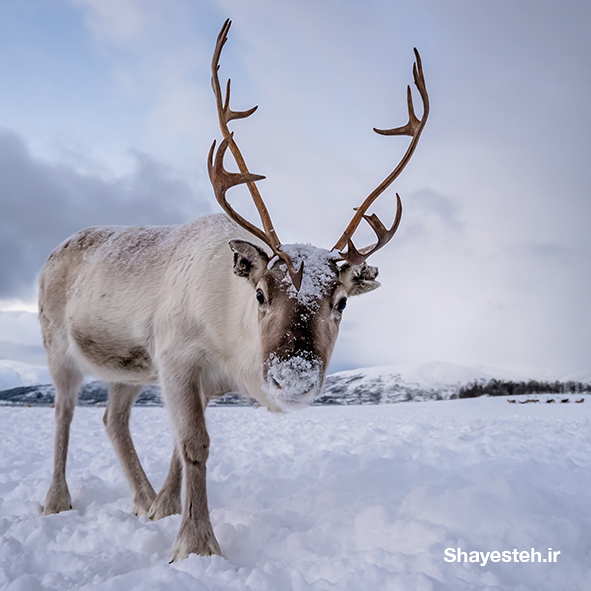در صورتی که اشکالی در ترجمه می بینید می توانید از طریق شماره زیر در واتساپ نظرات خود را برای ما بفرستید
09331464034
Topic:
Arctic deer live on islands in Canada's arctic regions. They search for food by moving over ice from island to island during the course of the year. Their habitat is limited to areas warm enough to sustain the plants on which they feed and cold enough, at least some of the year, for the ice to cover the sea separating the islands, allowing the deer to travel over it. Unfortunately, according to reports from local hunters, the deer populations are declining. Since these reports coincide with recent global warming trends that have caused the sea ice to melt, we can conclude that the purported decline in deer populations is the result of the deer's being unable to follow their age-old migration patterns across the frozen sea.
Write a response in which you discuss what specific evidence is needed to evaluate the argument and explain how the evidence would weaken or strengthen the argument.
گوزن های قطبی در جزایر مناطق قطبی کانادا زندگی می کنند. آنها در طول سال با عبور از روی یخ، از جزیره ای به جزیره دیگر به دنبال غذا می گردند. زیستگاه آنها محدود به مناطقی است که به اندازه کافی گرم باشند تا گیاهانی را که از آنها تغذیه می کنند حفظ کرده و به اندازه کافی، حداقل در بخشی از سال سرد باشد، تا یخ بتواند دریایی را که جزایر را از هم جدا می کنند؛ بپوشاند و به گوزن ها اجازه دهد از آن عبور کنند. متأسفانه، طبق گزارش های شکارچیان محلی، تعداد گوزن ها در حال کاهش است. از آنجایی که این گزارشات با روند اخیر گرم شدن کره زمین که باعث ذوب شدن یخ دریا می شود، همزمان هستند، می توان نتیجه گرفت که کاهش جمعیت گوزن ها در نتیجه عدم توانایی آنها برای دنبال کردن الگوی مهاجرت قدیمی خود در آن سوی دریای یخ زده است.
پاسخی بنویسید و در آن توضیح دهید که چه مستندات خاصی برای ارزیابی بحث لازم است و شرح دهید که چگونه این مستندات می تواند بحث را تضعیف یا تقویت کند.
• شاید پوشش گیاهی خوراکی برای این گوزن های قطبی به دلایلی نا مشخص (مانند تغییرات شیمایی) رو به کاهش باشد و این موضوع بر خوراک و زندگی این گوزن ها تاثیر گذاشته باشد.
• ما روند تغییر دما در ماه ها و سال های گذشته را نداریم و نمی توانیم بر پایه اطلاعات یک یا ۲ مقطع نظر قطعی بدهیم.
• شاید مسیر های عبور یخی بین جزیره ها به دلایلی نامشخص (مانند تغییرات شیمایی آب منطقه و ...) نازک و شکننده باشند و گوزن ها نتوانند به سمت جزیره های مورد علاقه خود حرکت کنند تا غذای مورد علاقه خود را بیبند.
• در مورد شکارچیان اطلاعات دقیقی در دست نیست و در مورد متغیر های شکارچیان مانند سن، جنسیت، سلاح شکاری و ... چیزی در متن اعلام نشده است.
• نظر شکارچیان محلی به معنی صحت این موضوع نیست. شاید بنا بر نظر شکارچیان محلی این گوزن ها کم شده باشند ولی در واقع اینطور نباشد و گوزن ها در مناطقی دور از نگاه شکارچیان حضور داشته باشند.
• مشخص نیست که شکارچیان در جزیره های گرم تر اقدام به شکار میکنند یا نه؟ و در چه فصل و ماهی از سال اقدام به شکار گوزن میکنند. شاید با تغییرات آب و هوایی (و در نتیجه آب شدن یخ ها و گرم شدن سکونتگاه اولیه گوزن ها و و به تبع آن،رشد گیاهان در همان سکونتگاه اولیه است)، زمان مواجه شکارچیان و گوزن ها بر خلاف گذشته باشد و شکارچیان از این موضوع بی خبر باشند.
• باید تاثیر روند اخیر گرم شدن زمین در مناطق قطبی کانادا بررسی شود تا ببینیم چقدر این گرم شدن بر آن منطقه تاثیر میگذارد و چه تاثیراتی می گذارد.
• شاید گرم شدن مناطق قطبی که در اثر روند گرم شدن زمین باشد، باعث رشد گیاهان در همان جزیره های قطبی شده باشد و گوزن ها نیازی به جا به جایی نمی بینند.
• تغییر الگوی مهاجرت لزوما به معنای کاهش جمعیت نیست و باید با تحقیق علمی اثبات شود.
Strategies
Argument:
This argument uses facts about the deer's migration pattern along with supposed global warming trends and anecdotal reports from hunters to explain a purported decline in the deer population in Canada's Arctic region.
In developing your response, you are asked to identify what specific evidence is needed to evaluate the strength or weakness of the argument and explain how that evidence would weaken or strengthen the argument.
What conclusions and assumptions are either explicit or implied in the original argument?
Facts and Assumptions:
a) Arctic deer travel across the ice from island to island to reach their food source. This fact leads to the assumption that an inability to reach some of these islands has led to a decline in deer population.
b) Global warming trends have caused sea ice to melt. There is no evidence in the passage that the ice between the islands used by the deer has melted. The reader also doesn't know when it melted.
c) Hunters report that deer populations have declined. Perhaps the deer have migrated to other feeding grounds. Tagging deer with radio devices would help to track their movements and deaths. The deer populations could have declined for other reasons. They may have become infected with the deer tick that affects their brains and, ultimately, causes their deaths. Hunting itself may have caused the decline. Some states in the US severely limit the number of does that can be tagged each year in an effort to preserve the deer population.
Your notes do not have to be exhaustive. As you begin to write your essay, your brain will generate new ideas. Make certain that you keep the directions in mind as you develop your ideas.
Sample 1:
his argument posits that the deer population in the Arctic region of Canada has declined due to melting ice caused by global warming. However, this argument is replete with vague suppositions and anecdotal information that cannot support either the actual decline in the deer populations or the reasons for that purported decline. Maybe global warming trends caused sea ice to melt, preventing the deer's traveling between islands in search of food. There is no evidence to support this. The writer needs to demonstrate that the habitat of the arctic deer was, indeed, affected by sea-ice melt. It appears that, for some of the year, the ice does melt, and that has always been the case. Considering the number of environmental watch-dog groups in existence, one should be able to find concrete evidence of where and when arctic ice melt has occurred. That evidence could support the argument in the passage or cause the writer to look for other factors or events that could affect the deer population.
What else could have caused a decline in the deer population? Wild animals are susceptible to danger from several fronts. Most animals have natural predators. Deer may be prey to wolves or coyotes. Is there evidence of an increase in the numbers of those animals in the arctic deer habitat? Deer populations have also fallen victim to the deer tick, a parasitic insect that takes up residence in the deer's brain and, eventually causes its death. Necropsy clearly discovers the presence of this tick. Alternatively, humans are also deer's natural enemy. It could be that the human residents have over-hunted the deer. Many areas have severely restricted the hunting of does to sustain their deer populations. Evidence of increased predation, deer ticks, or over hunting could weaken the argument proposed in this passage.
Despite the reports of local hunters, there is no concrete evidence that the deer population has declined. Has a census been conducted? It is not uncommon to tag wild animals with radio transmitters that allow officials to track their movements and their deaths. Such tactics might reveal that the deer have not returned to their traditional feeding grounds or that they have died off for some reason. A reduction in the deer's food supply would compel them to move or remain elsewhere. Alternatively, increased hunting in certain locations may compel deer to move to different locations, resulting in the appearance of a reduced population.
Neither the author nor his purpose for the argument has been identified. What is the writer's interest in the arctic deer population? The writer's agenda may influence his willingness to accept the unfounded information presented in the passage. The reader requires more empirical evidence before accepting the conclusions presented in this argument.
Sample 2:
In an editorial in a wild life journal, it was published that the arctic deer which live on islands in Canada’s arctic region are declining in number, as reported by the local hunters. The editorial has drawn similarities of this report with the recent global warning trends and drawn the conclusion that the decline in arctic deer population is due to inability of deer to follow their age old migration patterns across the frozen sea.
This argument is not based on reports from any authentic sources and is thereby very unconvincing. It rests on the feedback given by local hunters who themselves can be misguided as they are not the experts to notice the changing patterns. There is every possibility that the arctic deer have migrated to other regions leaving the hunters to make guesses. It is equally possible that in spite of the climatic changes, it is actually the local hunters who are responsible for the migration or decline of the arctic deer. Hence, the inability of deer to cope up with the changing climate is probably only a word spread by hunters to cover up the cruel pace at which they went on hunting the deer.
The author has quickly jumped to the conclusion that the population of arctic deer is waning because of global warming hampering their age-old patterns of migration across the frozen sea. Though it is true that global warming has caused sea ice in Polar Regions to melt, but it may not be the cause of decline of the arctic deer. They need a habitat cold enough for at least some part of the year and this condition is likely to have been met in the arctic region. Moreover, if global warming was the cause, then it should have affected other animals in the same region as well. No such issue is covered in the editorial.
The author was not only quick to assume that there is a decline in the arctic deer population, but also overlooked any causes of this, other than the global warming trends, when there can be different reasons for the decline of deer, if at all it is true. It could be due to their natural habitats being disturbed by increasing human interference, or due to increase in the number of their predators. The fall in number may also be associated with some sort of pollution of water or due to shortage of the plants they feed on. There may even be lack of suitable environment for their mating. Before arriving at any conclusion, the adaption trends of different animals, especially arctic deer in this case should have been studied. Since it is quite likely that just as birds change their timing and countries of migration, adapting to the changing climates, arctic deer have also adapted to the rise in temperature due to global warming and migrated to a different location.
Conclusively, the argument given by the author in the editorial of wild life journal is denounced due to lack of evidence. The author should have supported it with more reliable statistical data.
نظرات کاربران
هنوز نظری درج نشده است!


